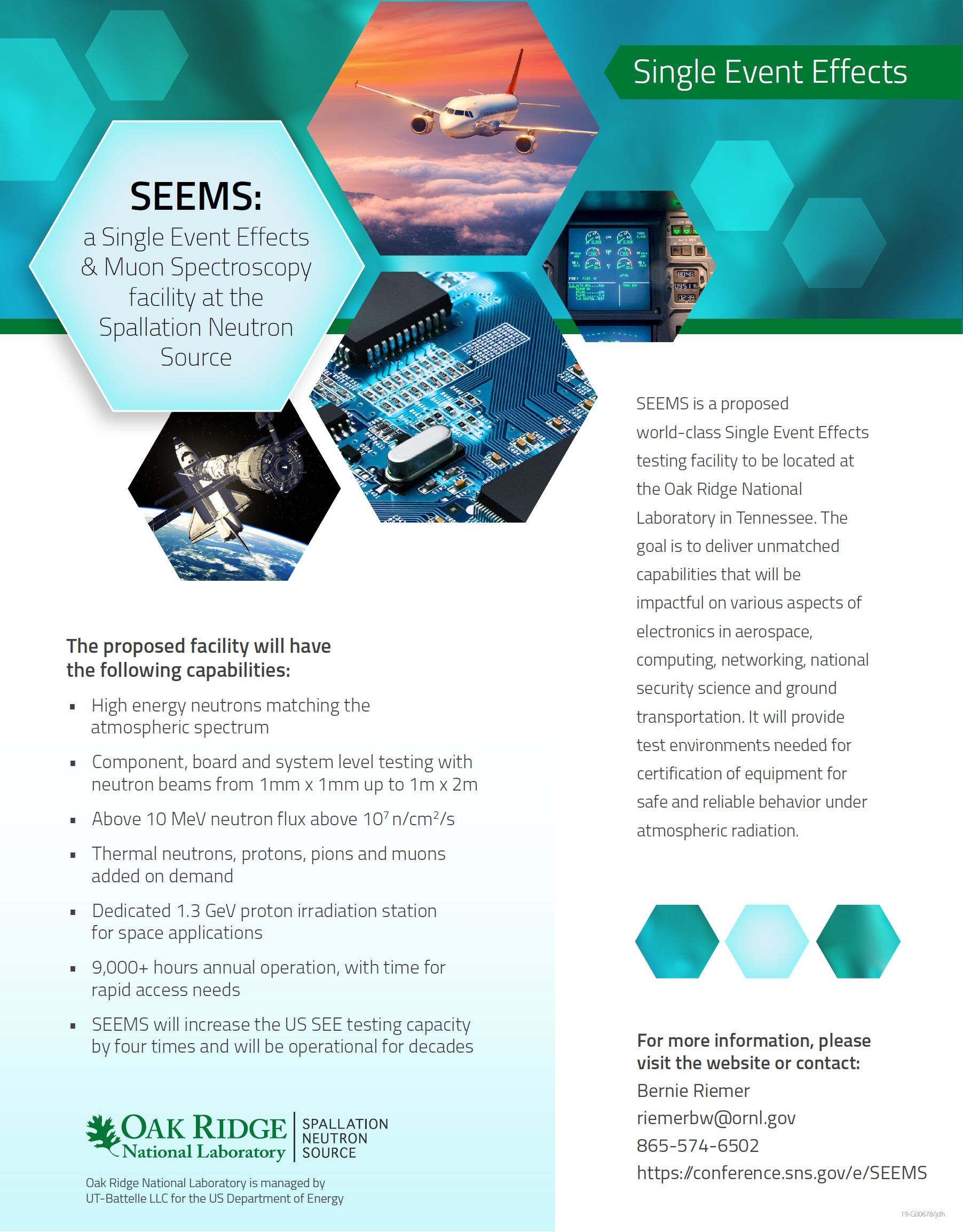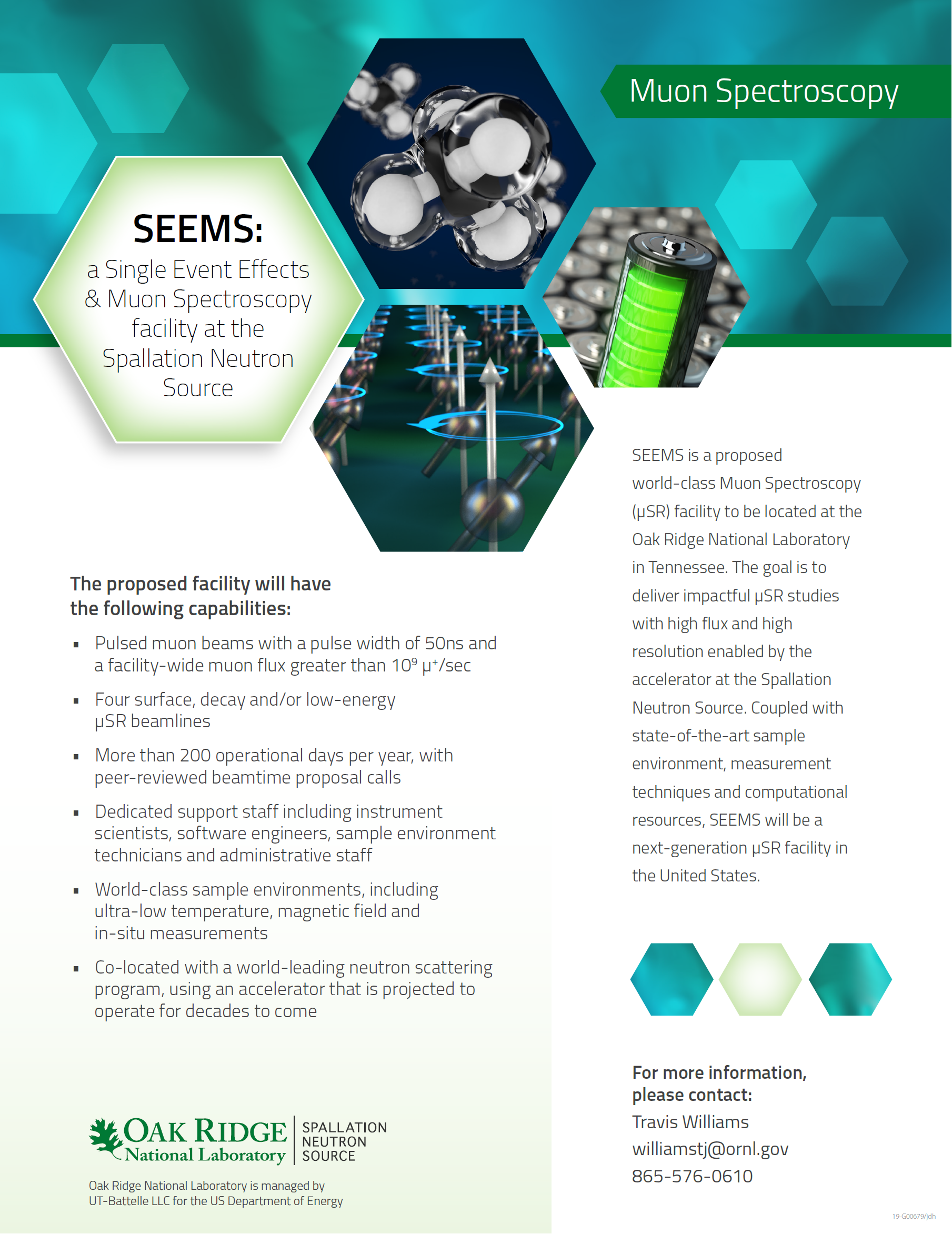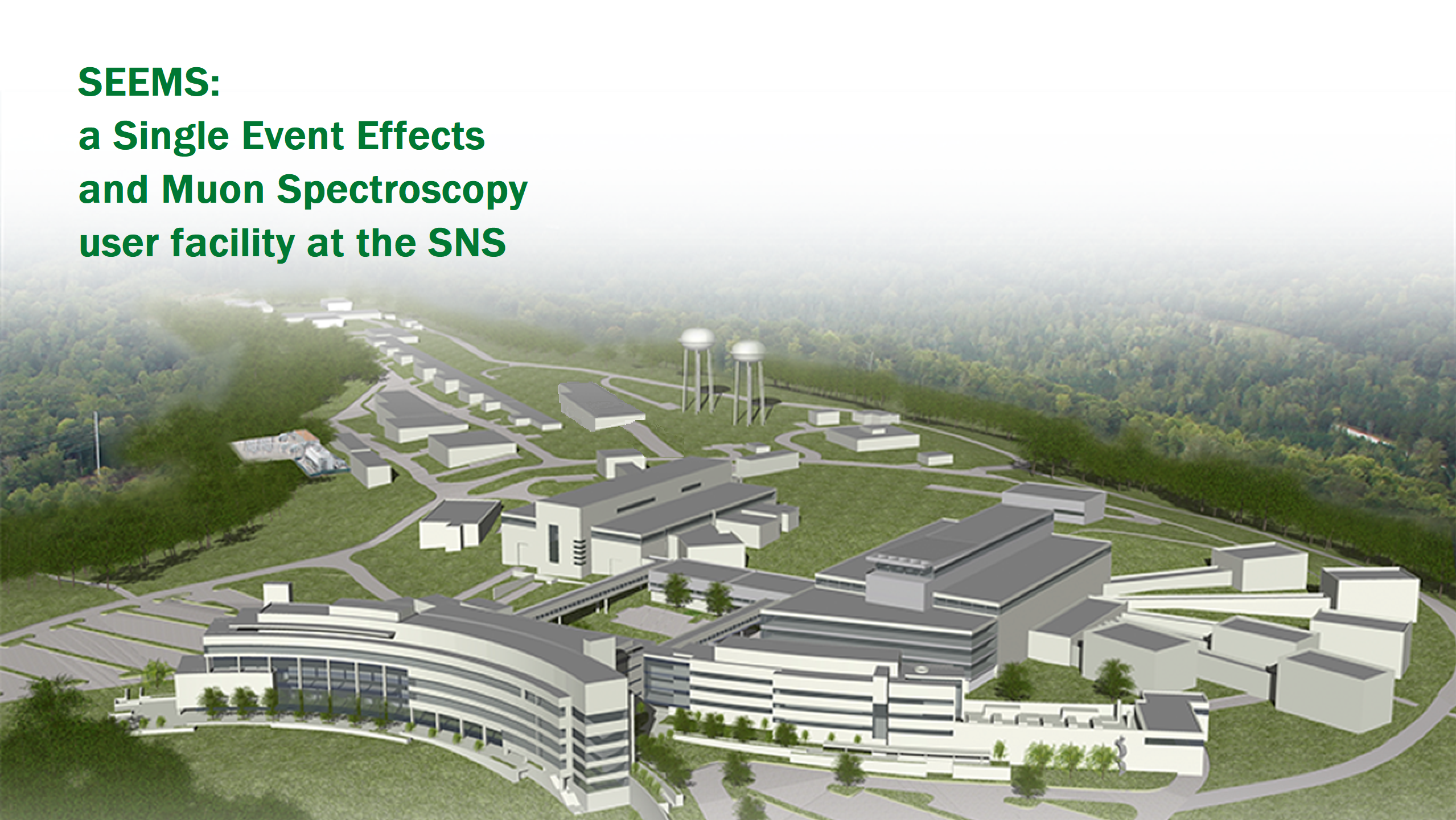
Facility Summary
The SEEMS facility is envisioned to be a small-scale version of a target station at the SNS. Containing a solid tungsten target and six beamlines, this user facility would simultaneously serve two distinct communities with world leading capabilities for each.
The first community exploits high-resolution muon spectroscopy (µSR) techniques. Despite a history of pioneering developments of the μSR technique in the US, there is no facility in the US capable of performing these experiments. Not only would the SEEMS research facility fill this lack of domestic scientific capability, but it would represent an orders-of-magnitude increase in flux over any pulsed μSR source currently in operation. μSR is a basic research technique that is highly complementary to neutron scattering, serving research in quantum materials, radical chemistry, engineering and battery materials.
The second user community served by SEEMS is research and testing of electronics for vulnerabilities to cosmogenic radiation, i.e., Single Event Effects (SEE). These phenomena are an urgently growing concern to commercial aviation, ground transportation, autonomous ground and air transportation, high integrity computing, spacecraft and defense applications. SEEMS will provide varied radiation conditions for rapid testing and evaluation of small electronic devices and large complete systems. SEEMS will provide 2 high-energy neutron test caves with high availability, and a mature user program infrastructure accustomed to facilitating all types of users. It will add capabilities for component or systems testing, and an option for future muon and/or proton irradiation.
The technology of the SEEMS target station at the SNS can simultaneously serve both the µSR and SEE missions – without affecting the primary neutron scattering science target station(s). Only 0.2% of the SNS accelerator beam would be sent to the SEEMS target station. With the relative youth and high availability of the SNS accelerator, the SEEMS facility could operate for 4,500 hours annually and for decades to come.
Key Features:

Single Event Effects (SEE)
Single Event Effects (SEE) are a collection of errors and faults in semiconductor devices that result from ionizing radiation – even at low levels. When ionizing radiation interacts with atoms in an integrated circuit, energy is transferred to recoiling ions. The ionization deposits charge in the which can result in device malfunctions. There are numerous types of malfunctions, some recoverable (soft errors) and some that cause permanent damage (hard errors). Depending on the function of the affected system the effects may be serious – loss of mission or risk of injury. Radiation in the atmosphere, originating from cosmic and solar rays, exists naturally from sea level to aircraft altitudes in varying intensity and type. The primary atmospheric radiation type driving SEE is high-energy neutrons, although thermal neutrons, muons, pions and protons are also of concern.
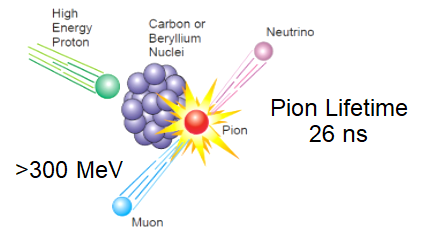
Muon Spin Relaxation/Rotation/Resonance (μSR)
Muon Spin Rotation/Relaxation/Resonance (μSR) is a spectroscopic tool using beams of spin-polarized muons for performing world-class scientific experiments in condensed matter physics, engineering, energy materials and chemistry. μSR has a long, well-established history of high-profile scientific publications in all of these areas and is currently performed at 4 facilities world-wide. Despite a history of pioneering developments of the μSR technique in the US, there is no facility in the US capable of performing these experiments. Not only would the SEEMS research facility fill this lack of domestic scientific capability, but it would represent an orders-of-magnitude increase in flux over any pulsed μSR source currently in operation.

Laser Stripping
The core technological development for this proposed facility is to use a laser to strip electrons from the H- beam of the SNS linac in order to create an optimal proton pulse to power a SEE/µSR facility. The laser transport line would terminate in the High-Energy Beam Transport area of the SNS linac where it interacts with the H- beam, stripping an electron to form a pulse of neutral H atoms. These neutron atoms would unaffected by electrostatic fields bending the primary H- beam into the accumulator ring and could be directed to the SEEMS facility. The capability of using a laser pulse to strip electrons from the H- beam has been successfully demonstrated, first in 2007 (here) with a very short pulse, and again in 2019 (here) with the optimal time structure needed for µSR.
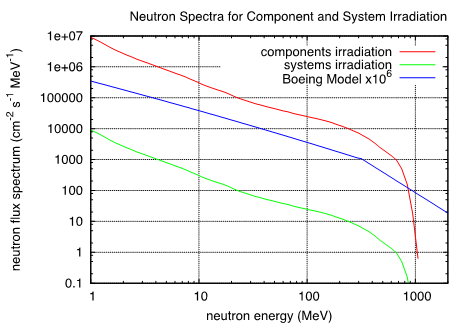
Neutron Flux and Capabilities for SEE Testing
The advantage of the proposed SEEMS facility is that the target design can be optimized for muon and neutron production. Using a solid tungsten target, two identical testing stations receiving high-energy neutron beams can be placed at the ±30° beamline positions, each 9×3 m (interior area) offering two irradiation positions, one for device testing and one for system testing. The position for component irradiation will be located at about 5 m from the target, and the beam line will provide fluxes of 10 MeV or greater neutrons of up to 107 n/cm2/s onto areas as large as 20×20 cm2. The position for system irradiation will be 14 m from the target, and will be possible to deliver peak above-10 MeV fluxes up to 1.3×106 n/cm2/s over an area of 0.56×0.56 m2. Alternately, it will be possible to deliver a beam over an area of 1×2 m2 with a peak above-10-MeV fluxes up to 2×105 n/cm2/s.
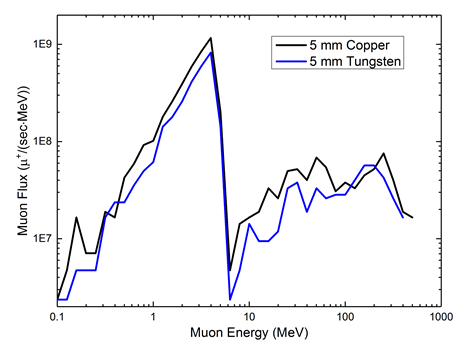
Muon Flux and Capabilities for µSR Measurements
A solid tungten target is not a usual muon target material, due to the increased production of neutrons, which would be an additional background for neutron instruments in facilities where muon targets are co-located with neutron scattering science instruments. However, as SEEMS would be well-separated from the neutron scattering science experiment hall, making this consideration less relevant. As a result, the muon flux that would be obtained from a 5 mm thick tungsten plate target would be approximately 109 µ+/s , nearly 200 times higher than any currently existing facility. Additionally, the use of laser stripping to power the facility allows for very short proton pulses, and the time width of the muon pulse is estimated to be less than 50 ns. This high brightness will allow for low-energy µSR measurements beyond what is currently possible. Finally, since the proton energy from the SNS linac is relatively high, there will be at least 10 times more decay muons produced than surface muons, opening up possibilities for measurements of thick samples and pressure cells.
Learn more about SEEMS:
G.J. MacDougall and T.J. Williams. (2017) Report from the Workshop on Future Muon Source Possibilities at the SNS September 1-2, 2016. ORNL/TM-2017/165 DOI:10.2172/1364319
B.W. Riemer, T.J. Williams and C. dela Cruz. (2020) Report from the Inaugural Meeting on the Opportunities at the SEEMS Facility June 11–12, 2019. ORNL/TM-2019/1441 DOI:10.2172/1598987
D. Louca, G.J. MacDougall and T.J. Williams. (2022) Report from: US Muon Workshop 2021: A Road Map for a Future Muon Facility February 1-2, 2021. Neutron News. 2022, 1. DOI:10.1063/5.0135721
Technical Articles:
T.J. Williams, G.J. MacDougall, B.W. Riemer, F.X. Gallmeier, C.R. dela Cruz and D. Louca. (2023) SEEMS: A Single Event Effects and Muon Spectroscopy facility at the Spallation Neutron Source. Rev. Sci. Instrum. 94, 033908. DOI:10.1063/5.0135721
Y. Liu, A. Rakhman, C.D. Long, Y. Liu and T.J. Williams. (2020) Laser-Assisted High-Energy Proton Pulse Extraction for Feasibility Study of Co-located Muon Source at the SNS. Nuclear Inst. And Methods A. 962, 163706. DOI:10.1016/j.nima.2020.163706

